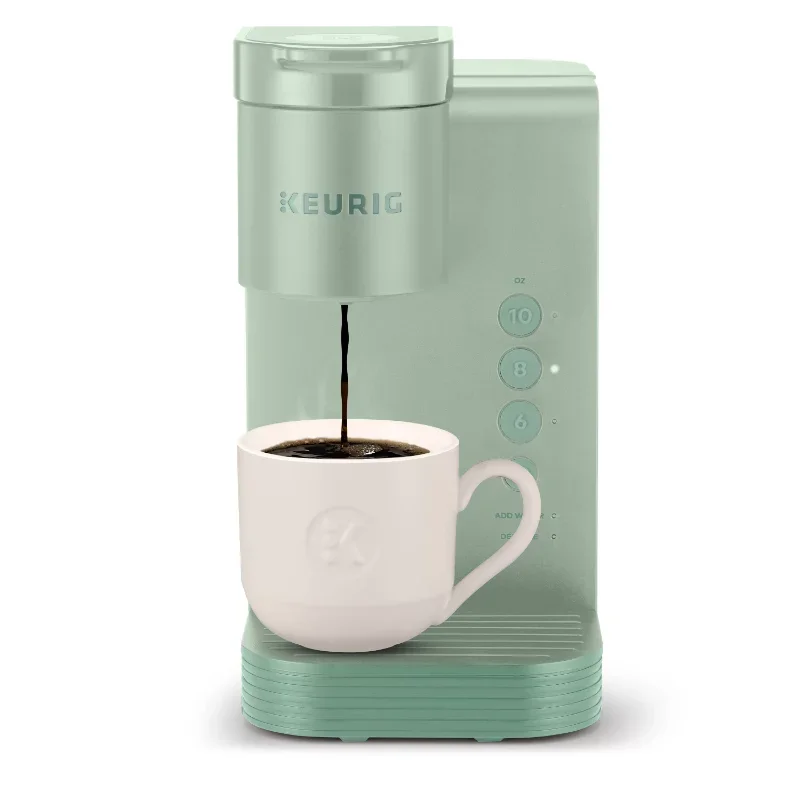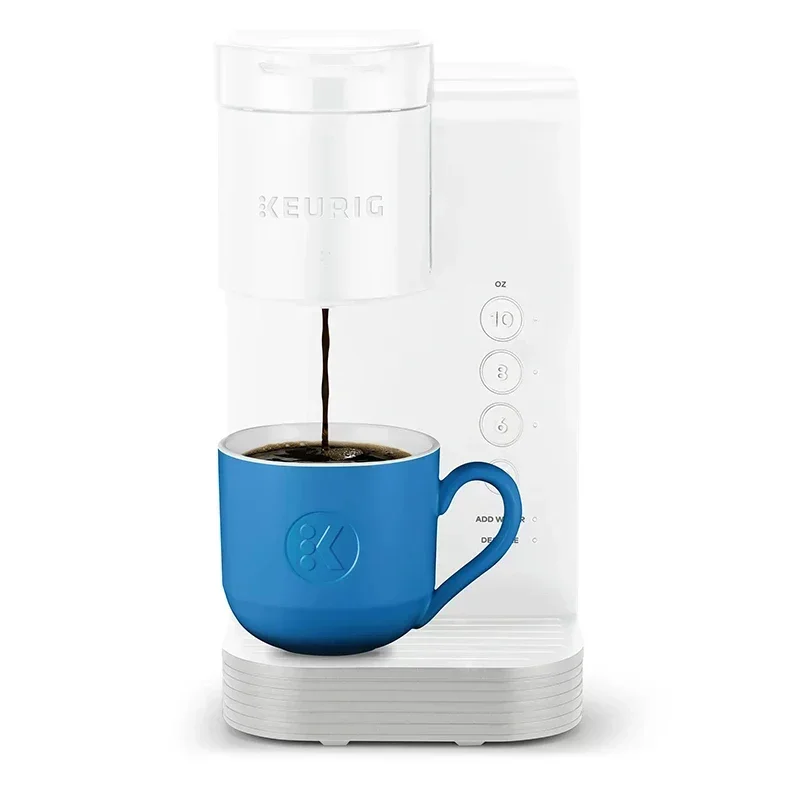
Overview of Keurig’s Power Usage
When it comes to understanding Keurig’s energy usage, it’s essential to know that Keurig coffee machines can vary significantly in power consumption. Generally, the average wattage for these popular single-serve brewers ranges from 900 to 1500 watts. The specific amount of energy used by a Keurig can be influenced by several factors including the model type, brewing temperature, and whether the machine is brewing a cup or maintaining heat.

For example, during its initial startup after being off, a Keurig can reach peak usage of 1500 watts as it heats water to the right temperature for brewing coffee. If you leave the power on, the Keurig keeps the internal tank up to temperature, utilizing between 200 to 400 watts when in heating mode. While this maintenance mode consumes less power, it still contributes to the overall energy usage, particularly if the machine remains on throughout the day.
Moreover, Keurig machines incorporate modern features to manage power usage more efficiently. Certain models are equipped with auto-off functions to conserve energy when not in use, and others might offer settings that allow users to adjust the machine’s power consumption based on their preferences. Additionally, newer Keurig models are designed to be more energy-efficient, reflecting a growing consumer demand for appliances that help reduce electricity bills and environmental impact.
In sum, a Keurig’s power usage varies, but understanding the average wattage range and how the machine manages power can help individuals make informed decisions about their coffee-making habits and potential energy savings.
Factors Affecting Keurig’s Wattage Consumption
To gauge how much energy a Keurig coffee maker uses, several variables come into play. Here’s a rundown of factors that can influence Keurig’s wattage consumption:
- Model Type: Different Keurig models use varied wattages. Standard models may use less power compared to premium ones with more features.
- Brewing Size: Selecting a larger cup size can increase the wattage need as more water needs to be heated.
- Brewing Frequency: More frequent use requires more energy. Each brew cycle consumes power.
- Heat Maintenance: Keeping water hot in-between brews can add to total wattage usage throughout the day.
Understanding these factors can help you estimate the energy cost of running your Keurig. Modifying some of these aspects can lead to reduced power consumption and savings on your electricity bill.
Average Wattage Usage by Keurig Models
When examining the energy consumption of Keurig models, it’s crucial to consider the average wattage. Most Keurig coffee makers operate within a 900 to 1500 watt range. Yet, this figure can differ from one Keurig model to another.
For instance, the Keurig K-Classic, a common model, generally uses around 1500 watts when brewing coffee. By contrast, the Keurig K-Mini Plus is designed for energy efficiency, often using less than 1000 watts. The difference in wattage between models results from varying heating elements and design efficiencies.
The higher-end models with additional features, such as the Keurig K-Elite, may exceed the 1500 watt mark during peak operation, such as the initial heating phase. However, these machines usually have eco-friendly options like programmable auto-off settings to help reduce their energy footprint.
To break down the energy use further, let’s take a close look:
- Standard Keurig Models: These typically use between 900 to 1200 watts.
- Premium Keurig Models: With more advanced heating systems, these can use up to 1500 watts or more.
- Compact/Mini Models: Aimed at lower power use, these models consume around 700 to 900 watts.
The wattage stated on the coffee maker’s label provides a rough idea of its power consumption during the brewing process. It’s wise to note these details when purchasing a new model if energy conservation is a priority for you.
Understanding the Cost Impact of Keurig’s Energy Consumption
How does a Keurig’s wattage usage translate to your monthly electricity bill? Let’s explore the cost impact. Keurig machines typically use between 900 to 1500 watts. This usage can affect your electricity costs, especially if the coffee maker is used frequently or left on throughout the day. Here are a few considerations:
- Daily Use Estimate: If you use a Keurig that consumes 1500 watts daily for 10 minutes, it results in 0.25 kWh. Multiply this by 30 days, and you’ll get 7.5 kWh per month.
- Energy Cost Calculation: To calculate the cost, multiply the monthly kWh by your local electricity rate. For example, if your rate is $0.12 per kWh, the cost would be $0.90 per month for those 10 minutes of daily use.
- Idle Consumption: When not brewing, if your Keurig uses 200 watts to maintain heat, the cost increases. Assuming it maintains heat for 4 hours daily, it adds about 2.4 kWh per month.
- Overall Impact: Combining brewing and idle consumption could result in a total monthly cost of a few dollars.
Keurigs, though convenient, can contribute a significant amount to the electric bill over time. This impact highlights the importance of using power-saving features and good energy practices. For example, turning off your Keurig when not in use can cut the cost. Investing in eco-friendly models with auto-off capabilities also helps reduce energy waste.
Understanding and managing the watts a Keurig uses is a simple step towards a more energy-efficient home. Moreover, it contributes to environmental well-being by reducing unnecessary power consumption.
 Comparison of Keurig with Other Coffee Makers in Terms of Energy Use
Comparison of Keurig with Other Coffee Makers in Terms of Energy Use
When discussing a Keurig’s energy use, it’s valuable to compare it with other types of coffee makers. Different coffee makers have varying energy needs based on their design and brewing process.
- Drip Coffee Makers: Generally, these use between 550 to 1200 watts. They’re comparable to a standard Keurig in terms of wattage.
- Espresso Machines: High-end machines may reach up to 1500 watts. Keurigs are often in this range too.
- Single-Serve Pod Machines (like Nespresso): These can also use 900 to 1500 watts, similar to a Keurig.
- Percolators: They tend to be lower in energy use, often 400 to 800 watts, using less than most Keurigs.
These comparisons show that Keurigs usually fall in the mid to high range of energy use among coffee makers. Keurigs and pod-based machines have comparable energy needs, while percolators are typically more energy-efficient.
When choosing a coffee maker, it’s clear that several alternatives to Keurigs can be considered for lower energy consumption. Each person’s choice may depend on their desired brewing style and willingness to manage energy costs. Keurigs offer convenience, but other models could save more energy and money over time.
Keurig’s Power Management Features
Keurig coffee makers are designed with a number of power management features to help conserve energy. Here’s how these features work:
- Auto-Off Function: To prevent energy waste, Keurig machines often come with an auto-off function. This feature automatically turns the brewer off after a set period of idle time. It reduces power consumption when the machine is not in use.
- Energy-Saving Mode: Some models include an energy-saving mode. It lowers the heating element’s power draw during idle periods.
- Programmable On/Off Times: Keurig machines with programmable settings allow users to set specific times for the machine to turn on and off. This helps ensure that the machine only uses power when needed.
- Temperature Control: Users can often select from multiple brewing temperatures. Setting a lower temperature can save energy, as the machine works less to heat the water.
Using these features effectively can lead to a considerable reduction in a Keurig’s energy consumption. By taking advantage of auto-off, energy-saving mode, programmable times, and temperature control, you can enjoy your coffee while keeping energy use in check.
Best Practices to Reduce Keurig’s Energy Consumption
To minimize your Keurig coffee maker’s energy usage, consider the following best practices:
- Use the Auto-Off Feature: Take advantage of the auto-off function. Ensure it’s activated to turn your Keurig off after brewing.
- Limit On-Time: Avoid leaving your Keurig on all day. Only power it up for brewing, then shut it down.
- Brew Back-to-Back: Plan your coffee times. Brew multiple cups one after another to capitalize on the heat already generated.
- Pre-fill Water: Use pre-warmed water to reduce heating time. This can cut energy use per cup.
- Opt for Energy-Efficient Models: When buying, choose a Keurig with eco-friendly features. These models save more power.
- Maintain Regularly: Clean and descale your Keurig. Good maintenance keeps it running efficiently.
- Unplug When Not in Use: Unplugging prevents passive energy draw. Practice plugging it in only when needed.
- Temperature Setting: If your Keurig allows, brew at a lower temperature. Lower temperatures consume less energy.
- Programmable Settings: Set specific on and off times. Use programmable settings to ensure the machine runs only when necessary.
- Cup Size Selecting: Use smaller cup sizes if you drink less. Smaller sizes use less water, thus less energy.
- Insulated Cups: Serve in insulated cups to keep coffee hot longer. This avoids reheating and saves energy.
By implementing these suggestions, you can reduce the number of watts your Keurig uses. Making small adjustments can lead to noticeable savings on your electricity bill and better energy usage at home.
 Solar Power Solutions for Keurig Machines
Solar Power Solutions for Keurig Machines
Keurig coffee makers, while convenient, can consume a significant amount of energy. Considering the average wattage usage of Keurigs lies between 900 to 1500 watts, an eco-friendly option for brewing your coffee could be the use of solar power solutions. Solar generators convert sunlight into electrical energy, providing an excellent way to power your Keurig while reducing electricity costs and minimizing environmental impact. Here are several ways you can integrate solar power with your Keurig:
- Choose the Right Solar Generator: Select a solar generator with ample wattage that meets or exceeds your Keurig’s wattage. Remember, you’ll need a generator that can handle up to 1500 watts for brewing.
- Estimate Energy Needs: Calculate how much power your Keurig uses daily to determine the size of the solar panel system required.
- Portable Solar Panels: Consider portable solar panels for small-scale brewing, especially if you enjoy coffee outdoors or are often on the move.
- Off-Grid Systems: For those in remote areas, a complete solar power system can keep your Keurig running without relying on grid power.
- Battery Storage: Invest in a solar battery that stores energy, allowing you to use your Keurig even when there is no sun.
- Monitor Usage: Keep track of your Keurig’s energy consumption with a solar power monitoring system to manage your solar energy efficiently.
Going solar is not only good for the environment; it also provides energy independence and can lead to significant savings in the long run. As solar technology improves and becomes more affordable, more Keurig owners are turning to the sun for their daily cup of joe. Solar power is clean, renewable, and an ideal alternative for powering your beloved Keurig coffee machine.